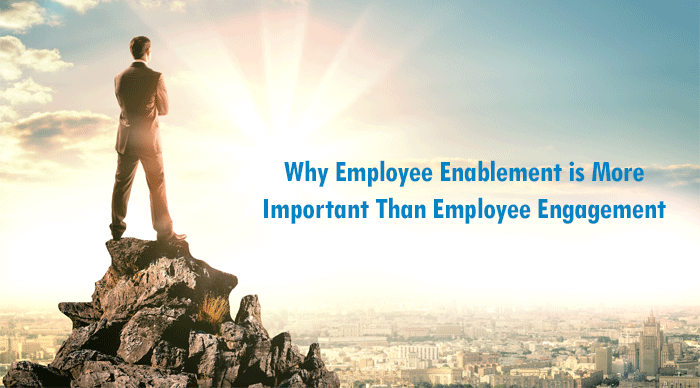The undeniable importance of employee enablement
By now it has been established that engaged employees are more productive at work. We truly believe that with a positive mindset, employees are more enterprising and passionate about their work. We also know that the cost of the disengaged employee can be high. Gallup estimates active disengagement costs anywhere between $450 billion to $550 billion annually.
While the benefits of employee engagement are clear, I believe that engagement is a means to an end, and that end is employee enablement. If your engagement strategy does not drive towards employee enablement, then your employees are likely to remain disengaged over the long term. The logic is simple – enablement brings empowerment and empowerment inevitably leads to greater engagement.
The Importance of Employee Enablement
Employee Enablement leads to Employee Engagement – Here’s How
Today we are in the age of the millennials – the digital natives. Let’s discuss the importance of employee enablement in context to millennial workers.
Dissolving geographical boundaries have ushered in the 24X7 economy. The ‘always- on’ environment demands greater transparency, more collaboration, and a workplace that promotes self-sufficiency. Organizations must be hyper-focused on identifying the barriers to employee productivity and efficiency.
To get more out of their engagement initiatives, organizations thus have to think about putting their employees in a better position to succeed. This can be achieved by first ensuring that the employees are in the right job roles and then by providing a supportive environment. This means ensuring that the workforce is equipped with the right tools, resources, and learning opportunities to remove all barriers to productivity.
Motivation is overrated – or are you measuring motivation the wrong way?
Engagement is something that is primarily motivational. Here performance is linked directly to the levels of motivation one has towards work. But what we need to evaluate is if motivation can just be an emotional response alone? There is a wide range of elements that impact motivation on the performance level too.
Even the most highly motivated employee will stop trying to perform if he/she just can’t get the task done. Or if they don’t have the right learning opportunities in the organization, or if training, learning, and development opportunities are not optimized leveraging technology and training demands a huge time investment from them.
These people might be highly motivated but might not be able to deliver up to their potential owing to factors such as imperfect processes, lack of the right training and development strategies, and organizational red tape. For example, field employees will be less inclined to attend a classroom training session as they are more mobile and are usually time-crunched. People look for information dissemination on the move. Give them the mLearning option with smart modules and bite-sized chunks of information that they can access while they are in transit and you will be pushing enablement closer to their work and helping them become more productive.
Information access is a business need
Today’s workforce needs the right processes in place that helps them become more successful at work. This means they need access to the right information, in context, and exactly when it can help them deliver.
They need the right tools to help them become experts fast so that they can hit the ground running. They need access to customized and relevant information delivered to them in a device agnostic manner so that they can stay in step with the speed of business.
Knowledge is power
The business environment has become exceptionally dynamic.
To drive timely response among your employees you have to recognize that enablement comes from education. A ‘one-size-fits-all’ approach will not be recognized by a workforce that is used to personalized, consumer-grade experiences. Employees are goal oriented and prefer thoughtfully designed experiences.
Whether it is a complex new technology training or a simple onboarding or pre-boarding exercise, knowledge transfer and training programs must ensure greater personalization, easy information absorption, and the capability to push enablement closer to where it is needed. Learning experiences should become adaptive, curated, relevant, and engaging to drive development. When an organization invests in learning and development opportunities it shows its employees it is invested in their growth story. Enabling them through knowledge empowers them immensely, addresses performance gaps, and gives their performance a proactive nudge.
A research conducted by Hay Group linking employee survey data to performance ratings showed “highly engaged employees are 10% more likely to exceed performance expectations. Highly engaged and enabled employees are outperform expectations by 50%.”
The math here is quite simple, do focus on the importance of employee engagement but focus more on driving opportunities for enablement. Because enablement leads to engagement.
Reach out to us at contact@enyotalearning.com or fill form to drop your details and one of our representatives will get back to you shortly. You can also view and try our learning management system – Abara LMS here.





